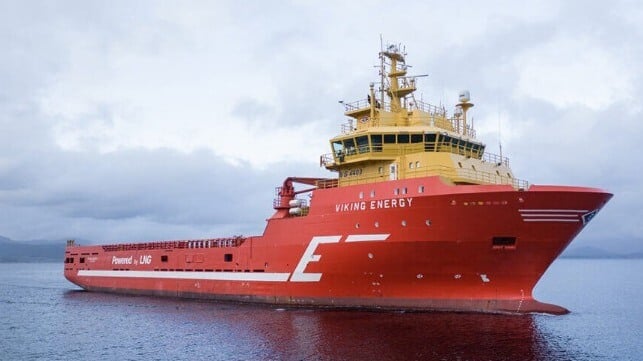Eidesvik, Equinor and Wärtsilä Plan Retrofit for First Ammonia-Powered OSV

In a pioneering project, Eidesvik Offshore as the vessel owner, Equinor as the charterer, and Wärtsilä will proceed with the conversion of an offshore supply vessel (OSV) to operate as an ammonia-fueled vessel. The companies believe it will become the first ammonia-powered OSV in the world when Viking Energy returns to service after the 2026 conversion.
Plans for the conversion were first announced in 2020 and were expected to proceed by late 2023. It is part of the Apollo Project funded by the EU’s Horizon Europe program designed to accelerate the transition toward a climate-neutral Europe by 2050. The companies report that in addition to the vessel conversion, the project will contribute to the preparation of regulations related to ammonia as a maritime fuel, as well as to establishing a value chain for ammonia bunkering.
The Eidesvik, Equinor and Wärtsilä Proceed with Retrofit for First Ammonia-Powered OSV was delivered in 2003 as the first LNG-fueled supply ship and has operated since its introduction for Equinor supporting its operations on the Norwegian continental shelf. The vessel is 6,000 dwt and approximately 95 meters (312 feet) in length. The vessel was fitted with a Wärtsilä battery system and in early 2026 they plan to begin the ammonia conversion. The conversion is projected to reduce emissions by at least 70 percent.
In addition to the Wärtsilä 25 Ammonia engine, Wärtsilä will supply the complete ammonia solution, including its AmmoniaPac Fuel Gas Supply System, the Wärtsilä Ammonia Release Mitigation System (WARMS), and a selective catalytic reduction (SCR) system designed for ammonia. A service agreement, covering maintenance, is also included in the contract.
"The offshore fleet on the Norwegian continental shelf is aging and needs renewal,” said Ørjan Kvelvane, Equinor's senior vice president for joint operations support. “Investing in new technology is expensive, and there are many uncertainties. At the same time, scaling up the use of operational technology to enable the necessary transformation is urgent.”
Equinor will contribute to the funding for the conversion to ammonia operation as part of its goal to halve maritime emissions associated with its Norwegian operations by 2030. The company also extended its charter for Viking Energy to run from April 2025 to 2030, with options for further extensions.
The project is at the forefront of the efforts to introduce ammonia as an alternative fuel for maritime operations. The companies highlight that the Norwegian government has announced that it will establish requirements for low-emission solutions from 2025, and zero emissions from new supply vessels from 2029.
The Apollo project aims to demonstrate the first full-scale ammonia engine operating in an in-service environment on board Viking Energy. Fortescue recently completed the first ammonia conversion on an offshore supply vessel and has been undergoing certification and demonstration testing in Singapore where the first bunkering was also completed. Last week, NYK announced the completion of the first retrofit of a tugboat previously operating on LNG to full-time ammonia operations. It will begin operating demonstrations in Tokyo Bay. Other vessels have been ordered to be ammonia-ready as the technology is perfected and introduced.
